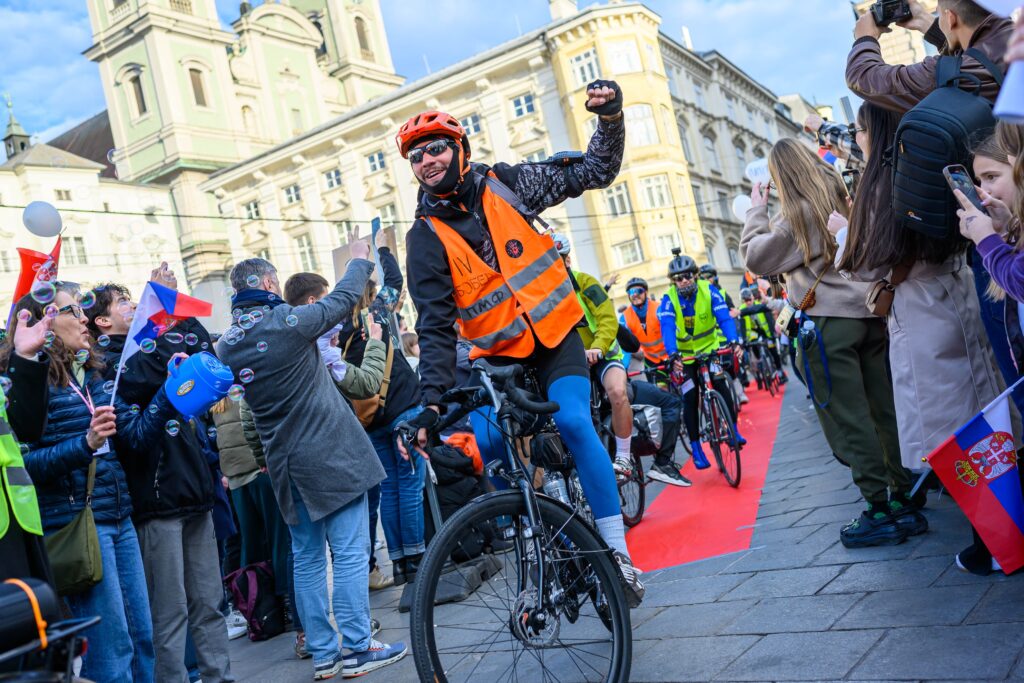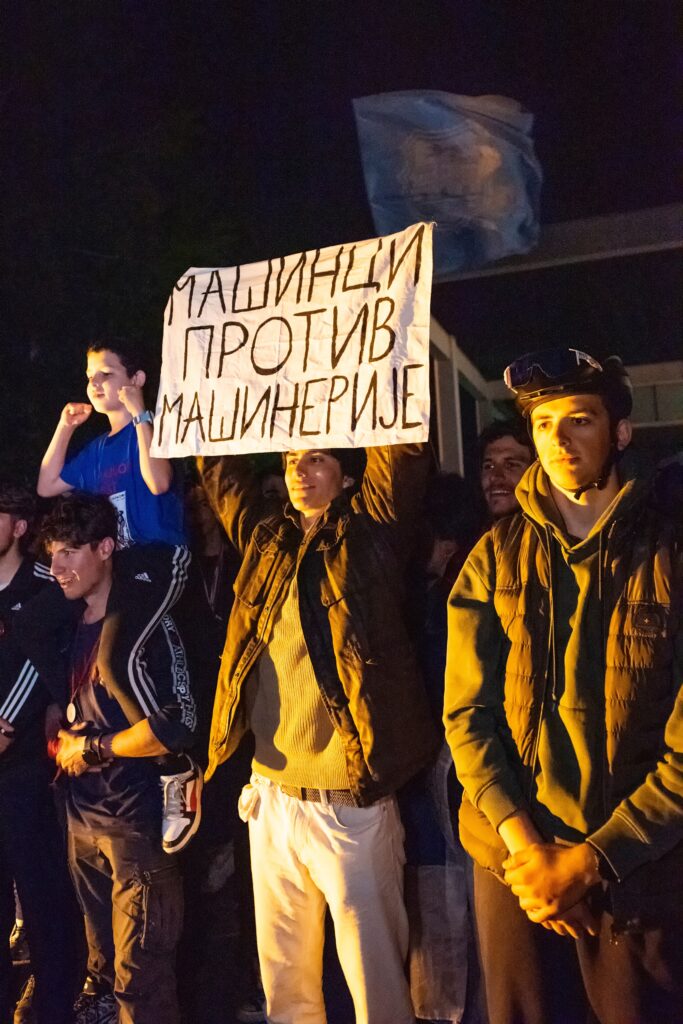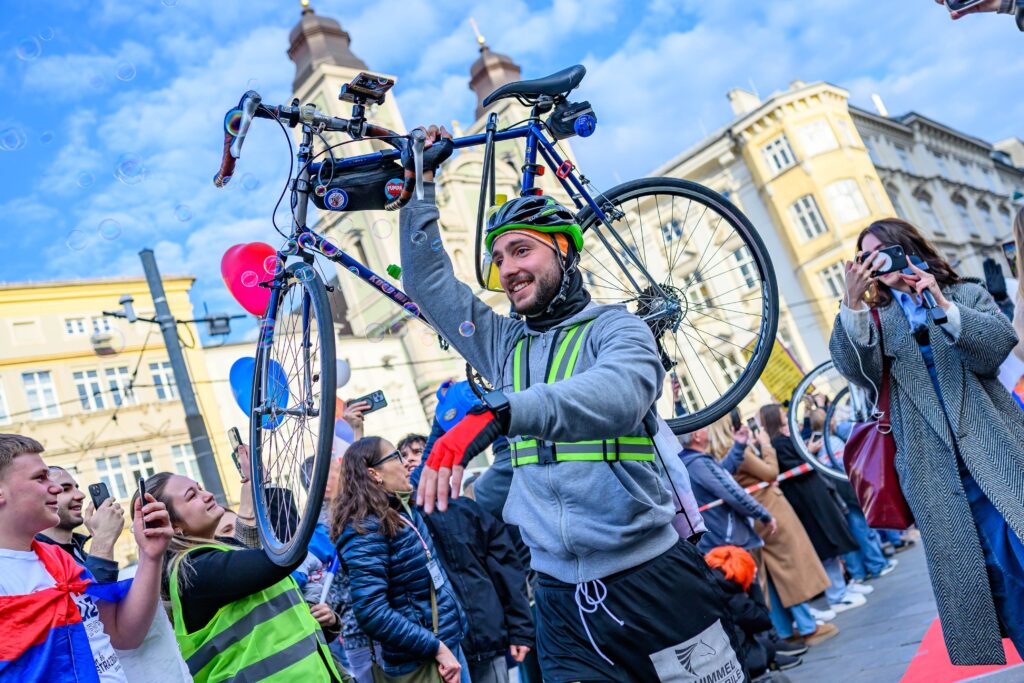Passive Observer or Active Partner: How Europe Addresses Serbia’s Crisis

Almost 6 months after the tragedy that claimed 16 lives in Novi Sad, the student protests in Serbia are far from reaching a conclusion, as the demands made by students still remain unresolved. While the protests keep spreading like wildfire, the future of the current political crisis in Serbia remains unpredictable. With political unrest inside of the country, the general public in Serbia has their eyes on the partners outside of the borders – waiting for a response from the center of Europe itself.
Pedal Diplomacy
This prompted students from Serbia to attempt to take on a trip to France with nothing but their bicycles to draw attention to the current issues in Serbia, face-to-face with European officials. After 14 days, the now well-known „Tura do Strazbura“ (Tour to Strasbourg) has reached its end, with the triumphant arrival of students from Serbia that managed to cycle an astounding distance of 1,400 kilometers. On their journey, they raised awareness all over Europe about their goal, which was to inform the Council of Europe and the European Parliament firsthand about their demands and the months-long fight against corruption that’s been happening in Serbia.
A delegation of MEPs from the European Parliament met the students as they arrived. Among them were Fabijen Keler from France, Irena Joveva from Slovenia, and Gordan Bosanac from Croatia, who were the recipients of a letter in which the main focus was on suspicions that the authorities in Serbia had used a sound cannon during the Belgrade protest on March 15th.
Students were promised that their letter will reach the rest of the MEPs & colleagues from the European Parliament, with Irena Joveva announcing that she will request the company of the president of the European Commission, Ursula von der Leyen.
According to an IPSOS survey from 2024, support for the European Union in Serbia fell to 40 percent, while Russia is considered the country’s biggest partner. This begs the question to what degree the EU plans to involve itself with the political crisis in Serbia.

EU’s Position on Serbian Protests – Schrödinger’s Support
During the end of March 2025, the president of the European Commission, Ursula von der Leyen, met with the Serbian president, Aleksandar Vučić, which turned out to be a move that would receive a fair amount of backlash in the European Parliament. As a reaction to this decision, a letter was sent to the President of the European Commission. It was signed by 31 MEPs that said that the timing of this meeting was “troubling“ and that this may send harmful signals given the gravity of the events that are unfolding in Serbia. The letter mentions that this could risk „further reinforcing perceptions that the EU ignores democratic backsliding.“
Marta Kos, the European Commissioner for Enlargement, recently wrote on her social media profiles that the EU demands from Serbia the same as the student movement in that country: “We are asking Serbia on its way to the EU exactly what the protesters are asking for: the rule of law, the fight against corruption, and public procurement.”
This dynamic feels like the best representation of the current positioning of the EU on this topic. On one side the European officials have been criticized for not speaking out in support of the student-led protests, while on the other side many MEPs have been praised for raising awareness within the European Parliament on how this passive stance of the EU doesn’t align with its core values.
Even with the usual criticism on the account of the EU being too passive, the recent report of Tonino Picula, European Parliament’s rapporteur for Serbia, tells somewhat of a different story.
Even with the usual criticism on the account of the EU being too passive, the recent report of Tonino Picula, European Parliament’s rapporteur for Serbia, tells somewhat of a different story
How Lenient is the EU Towards Serbia?
The Foreign Policy Committee of the European Parliament has adopted the report coming from Tonino Picula for Serbia for the period of 2023 and 2024. While the report does confirm the commitment of Serbia to European integration, it also points out shortcomings in fields such as rule of law, the judiciary, and the alignment with the foreign policies of the European Union.
The report acknowledged the same issues that were brought to light by student protests as well, claiming that the systemic problems within Serbia are particularly worrisome. It should also be noted that the report expressed concerns due to allegations coming from Serbian authorities that the EU member states were involved in the organization of student protests. Questionable media freedom and the lack of sufficient transparency of media ownership and funding were also pointed out as a problem.
At the end, the European Parliament expressed its condolences for the families of the victims of the tragedy in Novi Sad while calling for a fully transparent opening of the legal proceedings concerning the investigation carried out by competent authorities in Serbia.

From Conflict to Connection
A big part of Serbia’s path to the EU focuses on reconciliation among the neighboring countries in the western Balkans, and it seems that even with all of the European mediation in this process, the progress in this field was barely tangible. Another major success of the current student protests was the unification of students of different nationalities, the most notable one being the re-ignited friendship between Serbian and Bosniak students.
It appears that at the end of the day, Serbia’s alignment with the values of the European Union had to begin within its own society first. This shift within Serbian society was also initiated by a war veteran, Goran Samardžić, whose speech inspired admiration among both Serbian and Bosniak citizens, with a cathartic reflection on the wars of the 1990s.
“I want to tell the parents of these children from Novi Pazar not to worry, and that there are no more of “our” and “your” children; they are all our children,” said Goran Samardžić during the blockade of the RTS building on Takovska Street that has been taking place for days now. These words have been so impactful that they are still echoing around the region.
“I want to tell the parents of these children from Novi Pazar not to worry, and that there are no more of “our” and “your” children; they are all our children,” said Goran Samardžić
A Nation’s Voice on Wheels
Serbia stands at a crossroad, with its students leading the charge for change through an inspiring movement that captured the attention of Europe. Their Tour to Strasbourg was more than just a physical journey, it symbolized their determination to confront corruption and demand accountability from Serbian authorities. By looking to amplify their voices by adressing Europe, students have sparked important discussion not only in Serbia, but also inside of the European Parliament.
As European officials react with varying degrees of engagement, Serbia’s path toward integration without a doubt requires both internal and external transformation. The unifying spirit among citizens and neighboring communities highlight the importance of reconciliation as a cornerstone for progress. The students of Serbia are calling for collaboration and proactive support from the EU, ensuring that Serbia’s pursuit of justice, transparency, and democratic principles evolve into tangible reform.